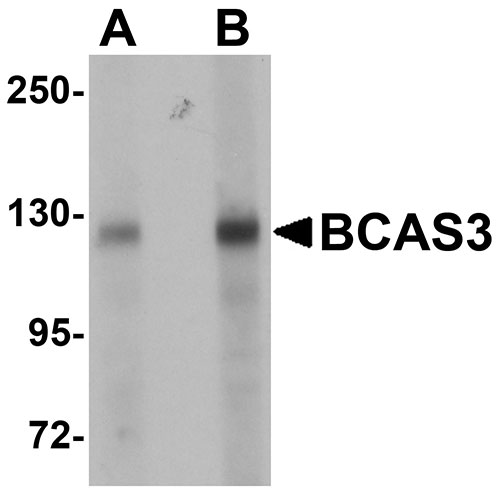BCAS3 Antibody
- 产品详情
- 实验流程
- 背景知识
Application
| WB, IF, E, IHC-P |
|---|---|
| Primary Accession | Q9H6U6 |
| Other Accession | EAW51415, 119571800 |
| Reactivity | Human, Mouse, Rat |
| Host | Rabbit |
| Clonality | Polyclonal |
| Isotype | IgG |
| Calculated MW | 101237 Da |
| Concentration (mg/ml) | 1 mg/mL |
| Conjugate | Unconjugated |
| Application Notes | BCAS3 antibody can be used for detection of BCAS3 by Western blot at 0.5 - 1 µg/mL. Antibody can also be used for immunohistochemistry starting at 5 µg/mL. For immunofluorescence start at 20 µg/mL. |
| Gene ID | 54828 |
|---|---|
| Other Names | Breast carcinoma-amplified sequence 3 {ECO:0000312|HGNC:HGNC:14347, ECO:0000312|MIM:607470}, GAOB1, BCAS3 {ECO:0000312|HGNC:HGNC:14347, ECO:0000312|MIM:607470} |
| Target/Specificity | BCAS3; |
| Reconstitution & Storage | BCAS3 antibody can be stored at 4℃ for three months and -20℃, stable for up to one year. As with all antibodies care should be taken to avoid repeated freeze thaw cycles. Antibodies should not be exposed to prolonged high temperatures. |
| Precautions | BCAS3 Antibody is for research use only and not for use in diagnostic or therapeutic procedures. |
| Name | BCAS3 {ECO:0000312|HGNC:HGNC:14347, ECO:0000312|MIM:607470} |
|---|---|
| Function | Plays a role in angiogenesis. Participates in the regulation of cell polarity and directional endothelial cell migration by mediating both the activation and recruitment of CDC42 and the reorganization of the actin cytoskeleton at the cell leading edge. Promotes filipodia formation (By similarity). Functions synergistically with PELP1 as a transcriptional coactivator of estrogen receptor- responsive genes. Stimulates histone acetyltransferase activity. Binds to chromatin. Plays a regulatory role in autophagic activity. In complex with PHAF1, associates with the preautophagosomal structure during both non-selective and selective autophagy (PubMed:33499712). Probably binds phosphatidylinositol 3-phosphate (PtdIns3P) which would mediate the recruitment preautophagosomal structures (PubMed:33499712). |
| Cellular Location | Nucleus. Cytoplasm. Cytoplasm, cytoskeleton {ECO:0000250|UniProtKB:Q8CCN5}. Preautophagosomal structure. Note=Localizes in the cytoplasm in stationary cells. Translocates from the cytoplasm to the leading edge in motile cells. Colocalizes with microtubules and intermediate filaments in both stationary and motile cells (By similarity) Associates with chromatin. Recruited to estrogen receptor-induced promoters in a PELP1-dependent manner. The BCAS3:PHAF1 complex is recruited to the preautophagosomal structures adjacent to the damaged mitochondria upon mitophagy in a PRKN-PINK1 dependent manner (PubMed:33499712). {ECO:0000250|UniProtKB:Q8CCN5, ECO:0000269|PubMed:17505058, ECO:0000269|PubMed:33499712} |
| Tissue Location | Expressed in stomach, liver, lung, kidney, prostate, testis, thyroid gland, adrenal gland, brain, heart, skeletal muscle, colon, spleen, small intestine, placenta, blood leukocyte and mammary epithelial cells. Expressed in undifferentiated ES cells Expressed in blood islands and nascent blood vessels derived from differentiated ES cells into embryoid bodies (BD). Expressed in endothelial cells. Not detected in brain. Expressed in brain tumors (at protein level). Expressed in brain. Highly expressed in breast cancers and in glioma cell lines. |
For Research Use Only. Not For Use In Diagnostic Procedures.
Provided below are standard protocols that you may find useful for product applications.
BACKGROUND
BCAS3 Antibody: The Breast carcinoma amplified sequence (BCAS3) gene is localized to 17q23, a region that is often amplified in breast cancers. Copy number gains at this region have also been reported in other tumors such as brain, lung, liver, testis and bladder. BCAS3 is thought to be an estrogen receptor (ER)-alpha co-activator that acts through PELP1, another ER-alpha that in turn activates BCAS3 expression. This may set up a positive feedback loop leading to ER-a signal amplification in the cell which may play a significant role in breast cancer. BCAS3 expression has also been observed in embryonic stem cells and vascular precursors, suggesting that it may also play a role in embryogenesis and tumor angiogenesis.
REFERENCES
Barlund M, Monni O, Weaver JD, et al. Cloning of BCAS3 (17q23) and BCAS4 (20q13) genes that undergo amplification, overexpression, and fusion in breast cancer. Genes Chromosomes Cancer2002; 35:311-7.
Sinclair CS, Rowley M, Naderi A, et al. The 17q23 amplicon and breast cancer. Breast Cancer Res. Treat.2003; 78:313-22.
Gururaj AE, Peng S, Vadlamudi RK, et al. Estrogen induces expression of BCAS3, a novel estrogen receptor-a coactivator, through Proline-, Glutamic acid-, and leucine-rich protein -1 (PELP1). Mol. Endocrinol.2007; 21:1847-60.
Siva K, Venu P, Mahadevan A, et al. Human BCAS3 expression in embryonic stem cells and vascular precursors suggests a role,in human ebryogenesis and tumor angiogenesis. PloS One2007; 11:e1202.
终于等到您。ABCEPTA(百远生物)抗体产品。
点击下方“我要评价 ”按钮提交您的反馈信息,您的反馈和评价是我们最宝贵的财富之一,
我们将在1-3个工作日内处理您的反馈信息。
如有疑问,联系:0512-88856768 tech-china@abcepta.com.























 癌症的基本特征包括细胞增殖、血管生成、迁移、凋亡逃避机制和细胞永生等。找到癌症发生过程中这些通路的关键标记物和对应的抗体用于检测至关重要。
癌症的基本特征包括细胞增殖、血管生成、迁移、凋亡逃避机制和细胞永生等。找到癌症发生过程中这些通路的关键标记物和对应的抗体用于检测至关重要。 为您推荐一个泛素化位点预测神器——泛素化分析工具,可以为您的蛋白的泛素化位点作出预测和评分。
为您推荐一个泛素化位点预测神器——泛素化分析工具,可以为您的蛋白的泛素化位点作出预测和评分。 细胞自噬受体图形绘图工具为你的蛋白的细胞受体结合位点作出预测和评分,识别结合到自噬通路中的蛋白是非常重要的,便于让我们理解自噬在正常生理、病理过程中的作用,如发育、细胞分化、神经退化性疾病、压力条件下、感染和癌症。
细胞自噬受体图形绘图工具为你的蛋白的细胞受体结合位点作出预测和评分,识别结合到自噬通路中的蛋白是非常重要的,便于让我们理解自噬在正常生理、病理过程中的作用,如发育、细胞分化、神经退化性疾病、压力条件下、感染和癌症。








